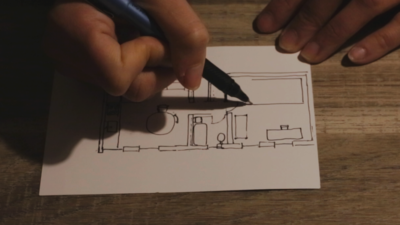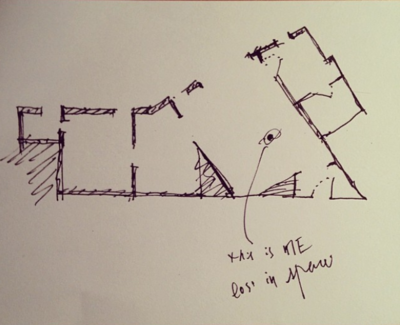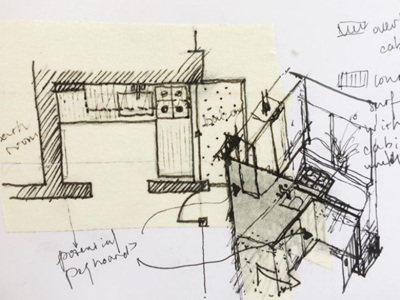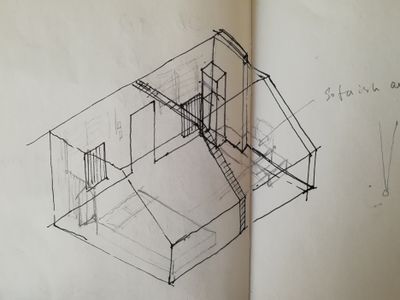Jujube/text-on-practice-2019
I have called myself an artist for the past two years. For a good part of it I talked about practice in its trendy, contemporary context: text-based practice, practice-based research, my practice in the intersection of ontology and epistemology, of space and time. I used words because I had them, not because I understood them.
I equated practice to the projects I made, or the ideas on which I based my projects. I armed myself with a certain language and was proud that I could create the optics around a narrative. I wrote no fewer than ten proposals in the year of 2017 for artist residencies, appropriating my practice each time to fit the parameters of an open call. Throughout the ones I did participate, I was able to create things; some of those even led to the curiosity and seriousness towards image-making I now hold close to heart.
But most of the things I created were neatly bookended by a start and end date and scoped with a well-phrased, sure-sounding outcome. Site-specificity was a convenient concept: everything the site introduced -- be it the environment, the people, the theme -- became a way to frame a sort of research. I would go on field trips and read literature about the locality, then try to write about it and produce something in the forms I knew, namely, text, photography and websites. I felt I had to keep on going to residencies in order to keep making. If I didn't I would lose the momentum, inspiration, or, dare I use the word now, legitimacy as an artist.
Practice became cool and abstract, or cool because it was abstract, or abstract because it was cool. It did not matter much: and that was why it was dangerous.
I was four when my parents enrolled me in piano classes. My fingers were so small that they could not press the keys all the way down. I practiced Tchaikovsky, Chopin and Beethoven everyday for more than an hour throughout elementary school, even when I hated it, which was most of the time. I stopped when I boarded for middle school. It was the first kind of practice I had in life.
Practice makes perfect. It's trite, and whether or not I admit it, it's true.
A conversation via email before I came to Piet Zwart.
I applied to a few programs in NL and was accepted by two. Now I am trying to decide which program to spend my next two years or three. My rationale for the first one is that I can treat it more like a long-term residency while becoming better as an artist-curator (more versed in theories and seeing and using connections). For the latter, I applied because I enjoy working with the lens — I got a nice camera last year and have been feeling so much potential with it. And I always refer to our conversation on craft: the lenses can become part of my tools and I can be more versatile in ways of manifesting my work. How has your trajectory been — I guess, how does theory and research inform your work and how have “forms” and “media” do so?
For me, theory and research on its own becomes overly academic and stagnant. It feels like ideas that are talked about, but never graduate into anything impactful. Keep in mind, I come from a mindset that tries to use art as a communication method for a broad audience - so art that stays purely in the realm of academia and research frustrates me. Likewise, crafts and skills on their own don't carry enough intent. I love process-driven work, I think it's really informative and a great basis for practice, but the real magic for me happens when the two combine. Somehow, when you layer theory and research with the process of craft skills - this third invisible element happens - the space created between the two elements that gives extra underlying meaning, purpose and intent for the work. It's hard to articulate, but I suppose when I look at an idea or creating a work, if I had to come up with a formula it would be something like this. Tool kit of skills + Concept = An art work that clearly communicates an idea through the use of a refined skill set.
I was in a playwriting workshop when I lived in New York. I wrote a short play (or a different draft of it) every week. On every Tuesday at the acting studio in Greenwich Village, where the afternoon sun poured through the wall of windows for the last golden hurrah before it set into the Hudson River, where the eighteen-year-old acting student from Czech Republic sat next to the balding Brooklyn Jewish poet to the Swiss princess to Elizabeth my love -- for that good year and a half, I brought a script into the room, cast my characters among the other workshop participants, and heard it read.
I still call myself a playwright.
I have been making films. The first thing I made was a documentary without knowing what documentary-making would take. I watched tutorials online about placement of the camera and checked out a field recorder to learn which buttons to push.
It ended up taking me a few months to make a 14-minute documentary filled with interviews and mal-focused shots of faces at the wrong shutter speed.
http://vimeo.com/ 327678876
For the second film, I wrote a script and went to a residency. I created an initial storyboard before departing Rotterdam, in which I set the main scenes near a lake to adapt a true story I heard a long time ago. When I arrived at the residency site, I was struck by the arid land.
Because I had only a week, I had to re-evaluate my script as I filmmed. I developed a routine right away. Each morning I'd leave the residency building, walk down into the barranco -- a type of ravine formed by erosion both by rainfall and agro-pastoral modification common in this region -- and observe the weather, geology, flora and fauna with my video equipments: a DSLR camera, two lenses, a field recorder, a pair of headphones and a tripod. At the end of the day, I would do a quick edit in front of the fireplace and create a new storyboard of the scenes that needed to be done the next day. The barranco inspired new vocabularies in the script and became the central image of the video. As I iterated through the images, I got closer to the image repertoire I wanted to build.
The method was noted in one of the tutorials:
- Abstract narrative
- Find location
- Improvise with the situation
http://vimeo.com/ 311241972
Fast forward to now — which means the first and second films, a photobook, a zine and a public speech later — I started shooting more documentaries. With each person in my recent documentaries, I try to create a situation in which the person will arrive at feeling(s): of warmth, clarity, resilience. On camera I try to capture the emotional journey that they go through -- sadness, nostalgia, loss -- as they write, draw, walk, perform, i.e. as they conduct a certain activity.
I have repeated a directing method for making these documentaries: I schedule an individual meeting with each of my subject, listen to what they want to share with me, and decide with them what is a situation in which they feel safe to be vulnerable. I met my subjects (with the exceptions of two, whom I already knew) through a performance I did at Garage Gallery in Rotterdam. My act was the reading of a wikipedia list of neighborhood names of Brooklyn, during which I teared up. With a softened voice and state of mind, I led the audience on a meditation about the space called home.
The meetings have been a crucial part of the process. I try to communicate efficiently (when, where, what expectations) while setting up the meetings. When I finally meet them in person, I remain as open, honest and attentive as possible and listen.
Some of the situations I have created so far are:
- take Lara to Maastunnel for the installation of Tunnel of Love during Valentine's week
- go stationary shopping with Mia and film her draw a picture for her dad in a cafe
- follow the plaster casting process of Amy at the ceramic station
- follow the journey of Renate from Rotterdam to the Hague, film her write a letter at James Turrell's Celestial Vault
I filmed the situation with Lara by myself, but found it extremely difficult to conduct the filming, recording and directing all at the same time.
For the two shootings that followed I recruited Cem and Ugo, peers from the Master's program, respectively as the cinematographers. In this way I was able to focus on the sound and direction.
"You talk a lot about what you film and why you film it, but how do you film them?" Someone asked one day, and I could not respond. It felt I was asked to elaborate on the choice of obstreperous in the paragraph of the short story I would be writing when I had just learned the alphabets enough to spell o-b-v-i-o-u-s.
I changed my workflow again and became more deliberately involved in cinematography. For the shooting with Renate, Cem and I divided responsibilities. He shot the distant takes and the environment and I did the close-ups. Considering that it was one of the most vulnerable stories in these situations, we had an additional meeting with Renate before the shooting, and discussed our approaches together. What we tried to establish were boundaries, safety and trust.
video of Renate and others to be shown at the assessment
The place I sublet in Rotterdam when I first moved here was covered in dust trapped in grime. I spent a couple of days scrubbing the shower and wiping off the unknown particles coating the spice jars. One morning I drew an isometric plan of the kitchen. I drew it so that it would be better, so that every time I picked up the broken handle of a pot there would be something to hope for, even though when the end of my sublet came there was neither improvement nor fulfilment. When I moved from one house to another in Washington DC, staring at the empty room I drew a floor plan. By the window I shall have a desk no wider than 48 centimeters, and by the wall a shelf permitted by the ceiling height. I was quite obsessed with cushions and light bulbs. I wanted to fill the empty walls hard corners with not cold-tiled echoes but what softness that'd catch me. I wanted to know it, call it mine, and take care of it.
The first months in Rotterdam I kept walking through the apartment I dwelled in New York.
There is a walk-in closet on the right. A giant mirror in front of you, a false wall that divides the living room into entry way and open kitchen. Walking past the right side of the couch, you see the kitchen sink, the stove, oven, the cabinets above them. (The sink is white and deep, the faucet tall with a generous curve, almost the same as the one you once saw in a farmhouse on the border of Vermont and New Hampshire where the owner decided to follow the Swedish vernacular.) You open the fridge. There is a bottle of coconut water (pink when you bought it, which the label says is a natural coloration) and a couple of Siggi's yogurt. You open one cabinet and find plates, bowls, mugs with a shade of grey purple which some interior color reference book has claimed slate. There is a round table where you eat and write. A bookshelf whose top you filled with play scripts. A map of the Second Valley in Pennsylvania that you bought for the thin topographic lines and the humility it reminded you of.
I moved from an airbnb to the dusty sublet to a six-month temporary rental to my current place. The first week I moved in I measured the walls and drew the room.
I grew up under Buddhist influences. My mother is a Buddhist, and I remember being dragged to the temples to pay respect to the Buddha. I would enter the temple, light up the incense, enter one wing and say hi to the Bodhisattvas, then the Buddha, gold and big and with the droopy eyes that they call kindness. My mother still keeps a Buddha room in the house, where she goes everyday to make good wishes.
When I was in college I had the chance to design a building for one of the religions in the world as my architecture thesis. I chose Buddhism because I could finally question, openly, whether it was a blind superstition. After all, I prided myself with the aptitude from the Enlightenment.
Despite my skepticism, I arrived at this: if the repeated act means anything, it spreads existence -- and the anxiety, contemplation, peace thereby -- across the most mundane tasks. And if you have wished for the health and safety of your family, every morning, for the past 60 years in your life, you have known one thing or two about love.
I have been writing this imaginary correspondence with Su, a Korean artist I met at a residency and have not contacted since the residency ended. I started writing to her from the beginning of my time at Piet Zwart, in September 2018. After writing these letters for more than half a year, they have become documents of the more personal feelings that I have no one to share with in Rotterdam. I included two of these letters for a recent assessment as a way of showing the sometimes unconscious drive of my process. (Perhaps I will bring them to light one day.)
I made bread at a bakery for a period of time. I would get up at 6:45 in the morning and leave the house by 7:30. By 9 I would have mixed at least 20 kilos of dough for one kind of bread and in the middle of waiting for the autolyzing to finish for the second kind. By 10 I would have folded some dough in development. Folding the dough was like tucking a child to bed -- I'd lift up the sides of the dough as if it were a blanket, stretch them and place them neatly under their own weight. In four hours I would start shaping the bread, first by cutting them into 1100 or 940 gram pieces. If it was a long loaf used by restaurants, I'd flatten out the dough a bit length-wise and roll it back with the shorter edges, then cradle it with the pinky side of my palm and push the mass towards my body to create tension in the surface. If it was a regular or small loaf, I'd fold the corners into the center and cradle from there. Sometimes, when the dough was very wet (because the temperature was high or because someone put it a bit more water in the mix that day), I would have to fold in the corners twice.
Before I knew it it would be five thirty in the afternoon. I would have set five timers (three to four times for each one), oiled eighteen tins, run the dishwasher on intensive wash thirty-one times, pushed three carts of fourty plus proofing baskets to the cooler, swept the floor, wiped the counter and sink and finally, changed out of my bakery shoes.
I would be tired. My calves would be swollen. My shoulders would be stiff.
I would say as I left the door: see you tomorrow.
For works referenced in this essay, please visit Jujube/voor-assessment.




